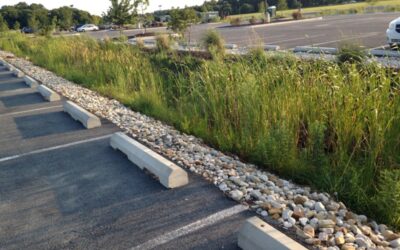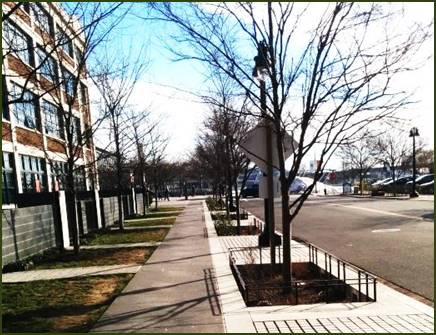Types of Green Infrastructure

What is Green Infrastructure?
“Green infrastructure” means a stormwater management measure that manages stormwater close to its source by:
- Treating stormwater runoff through infiltration into subsoil;
- Treating stormwater runoff through filtration by vegetation or soil; or
- Storing stormwater runoff for reuse.
Green Infrastructure (GI) best management practices (BMPs) are intended to mimic natural hydrologic conditions and, thus, typically incorporate infiltration and/or vegetation more than traditional stormwater management methods.
The main stormwater related benefit of GI vs traditional methods of managing stormwater is stormwater volume reduction. Other GI benefits include reduced flooding and improved water quality in watercourses since the retained portion of the stormwater never reaches the downstream watercourse. By contrast, more traditional stormwater management systems do not generally retain a significant amount of stormwater runoff. GI also results in numerous non-stormwater co-benefits to communities, including reduction in urban heat island effect, decreased energy use, removal of pollutants from the air through greater utilization of vegetation, beautification of public spaces, and increased property values.
The most widely used GI stormwater BMP is the rain garden, which is a type of small-scale bioretention system. Other examples of green infrastructure BMPs include green roofs, dry wells, pervious paving systems, infiltration basins, cisterns, and even certain types of manufactured treatment devices. For more information on BMPs, please see the New Jersey Stormwater BMP Manual, which is available at NJ Stormwater Best Management Practices Manual.
GI was required to be investigated as part of Long Term Control Plan (LTCP) requirements in the Combined Sewer Overflow permits issued in 2015. Subsequently, GI has become an important part of many of the proposed LTCPs. It is now being incorporated into renewal permits and is also being implemented in several combined sewer areas.
Resources
NJ Stormwater BMP Manual
The New Jersey Stormwater Best Management Practices (BMP) Manual provides guidance to address the standards in the proposed Stormwater Management Rules, N.J.A.C. 7:8. The BMP manual contains examples of ways to meet the standards contained in the rule. The methods referenced in the BMP manual are one way of achieving the standards. An applicant is welcome to demonstrate that other proposed management practices will also achieve the standards established in the rules.
The EPA has a dedicated page for Green Infrastructure, where information on planning, design, and research can be found. This page also includes information on available funding for GI.
Sustainable Jersey
Sustainable Jersey is a non-profit organization providing resources and a certification program for municipalities in NJ that want to go green, save money, and take steps to sustain their quality of life over the long term. Green Infrastructure Planning and Green Infrastructure Implementation are two related actions available for points.
American Society of Landscape Architects (asla.org)
ASLA’s mission is to lead and educate the public on sustainability and preserving our natural and cultural environment. Their website includes a wealth of information on Green Infrastructure including case studies and ways to save money, including their report, Banking on Green.
